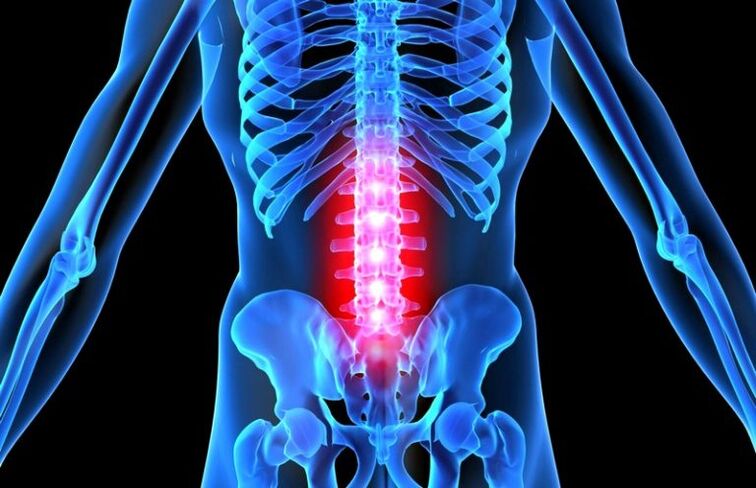
Translated from ancient Greek, osteochondrosis means ὀστέον - bone and χόνδρος - cartilage and is characterized by complex degenerative changes in the articular elements of the bony skeleton. Almost every part of the skeletal structure is prone to this neurological disorder. There may be thoracic and / or cervical discs in the affected area. However, it is lumbar spine osteochondrosis, the symptoms and treatment of which are most common in modern diseases, that is the cause of discussion and concern among practicing neuropathologists.
Pathogenesis or development of the inflammatory process
Every organism that grows up changes its physiology. This leads to diffuse changes in the vascular bed of the intervertebral disks of the bone skeleton. The supply of the lumbar spine with nutrients is made more difficult by various traumatic conditions and / or constant dynamic loads on this part of the spinal structure. Inadequate nutrition with the necessary microelements is further complicated by osteochondrotic processes, which lead to the loss of the elasticity and strength properties of the cartilage joints. With osteochondrosis of the lumbar spine, the symptoms of the disease are most active with asymmetrical and irrational work of the muscles of the spine, which is noted under various conditions:
- insufficient warming up of muscle tissue;
- wrong posture;
- Congestion of the intervertebral joints due to excess fatty tissue;
- Use of mattresses on a soft surface during a night's sleep;
- strong mechanical and / or dynamic loads on the lumbar spine;
- Body stress;
- with exacerbation of chronic pathologies.

The supply of the lumbar spine with nutrients is made more difficult by various traumatic conditions and / or constant dynamic loads on this part of the spinal structure.
If lumbar osteochondrosis is detected, symptoms of a neurological disease due to premature medical intervention can lead to more serious neurological pathologies, such as sciatica, spinal hernia, disc injury, and other complications.
Why does lumbar osteochondrosis occur?
To date, the problem of diffuse transformations in the intervertebral space has not been fully investigated. With osteochondrosis of the lumbar spine, symptoms of manifestations of neurological pathology often appear in middle-aged people from 35 to 45 years.

Nervous overload and stressful situations can also lead to the outbreak of the disease.
At this most efficient age, static and dynamic loads appear on the spine. However, according to experts' observations, back pain is starting to bother more and more people in the younger age group. As early as the age of 18 to 25, young people become patients in neurological treatment departments. This is due to poor physical activity, obesity, poor posture, and general deformation of the joints that cause lumbar osteochondrosis.
Symptoms and treatment of neurological pathology, it is desirable to identify them at the earliest stage of the development of the disease and respond appropriately to them.
Other causal factors that lead to lumbar spine osteochondrosis include:
- hereditary forms;
- insufficient supply of the cartilage vessels with micronutrients;
- violation of metabolic processes due to various circumstances;
- uneven development of the musculoskeletal system;
- sedentary lifestyle;
- Disorders of the body related to the work of the endocrine system;
- Weakening of muscle structures due to the harmful effects of alcohol, smoking and other bad habits;
- a consequence of various chronic pathologies;
- segmental instability of the elements of the spine;
- nervous overload, stressful situations and other components.
However, when diagnosing osteochondrosis of the lumbar spine, the symptoms of neurological pathology in women due to disorganization or the development of disorders related to hormonal changes can be diagnosed. At the age of 35-45, the female body begins to undergo significant physiological changes that affect the functional work of all areas of the bone and cartilage in the spine.
Symptomatic signs of the disease
With osteochondrosis of the lumbosacral region, the symptoms of neurological pathology are noticeable with aching pains in the lumbar region, which lead to numbness, discomfort and pain in the lower back. The lack of adequate adequate therapy can aggravate the situation and lead to complete atrophy of the muscular structures in the lumbosacral spine. A variety of factors can cause increased pain, including sneezing, coughing, sharp turns, and lifting heavy objects. The cuts that occur in the lumbar area are most commonly made in the buttock area and the calf area of the lower extremity. In lumbosacral osteochondrosis, symptoms of a neurological disorder can be determined by the following signs:
- Delivery of acute painful pains in the sacral region of the spine and in the organs in the pelvic area;
- Loss of sensitivity;
- Discomfort in the innervated muscles of the lumbar spine;
- Hypotension and hypotrophy.

All of these symptomatic signs result from damage to the nerve roots in the intervertebral discs of the lumbar spine.
Disease stages
When diagnosing lumbosacral osteochondrosis, the symptoms and treatment of the disease depend on the stage of the inflammatory process. So, according to the results of a diagnostic examination, several specific signs of inflammation of the lumbar spine can be identified:
- The first stage is determined by slight sensations of pain in the lumbar area, which increase under the influence of physical exertion. Only with sudden movements does the patient feel a sharp, sore, or dull pain in the lower back. There is no pain in the relaxed state.
- The second stage is determined when the distance between the intervertebral discs decreases due to compression and degenerative-dystrophic formations appear in the annulus fibrosus. A cutting, sharp pain that radiates to the ankle region of the lower extremity, the buttocks, and the outside of the thigh is due to the pinching of the nerve endings between the intervertebral discs in the vertebral space.
- The destruction of the annulus fibrosus occurs in the third stage of the disease, and this is the most favorable time for the formation of a herniated disc. Intense lumbar pain is permanent due to a significant deformity of the lumbar spine.
- The last, fourth stage of osteochondrosis of the lumbar spine, the symptoms, treatment and rehabilitation of which are the most difficult in the entire process of destruction of the musculoskeletal system. This stage of the disease leads to the disability of the patient, as well as his complete or partial immobility.
However, any form of osteochondrosis should not cause fear and panic in a person; only adequate adequate medical treatment is required.
Lumbar osteochondrosis: symptoms and medications
Based on the results of the symptomatic signs and the establishment of an appropriate diagnosis according to the stage and form of the disease, specialists select the appropriate drug treatment, which is based on the use of pharmacological combinations of different orientations. The main treatment goals in solving the problem are:
- Slowing down the degenerative-dystrophic processes in the lumbar area through the implementation of appropriate therapeutic and prophylactic measures;
- Elimination of dysfunction of the spinal nerve endings;
- neutralization of painful sensations;
- functional restoration of muscle tone of the lumbosacral region;
- Return of the patient to an active life.
When choosing a drug treatment method, the age and gender of the patient and the condition of his endocrine system play an important role.
The main focus in drug exposure is the elimination of pain through the appropriate selection of pharmacological analgesics. With anti-inflammatory drugs, you can neutralize the destructive processes in the muscle structures of the spinal region. The most effective pharmacological agents are nonsteroidal anti-inflammatory groups.

The most effective pharmacological agents are nonsteroidal anti-inflammatory groups.
If NSAIDs (nonsteroidal anti-inflammatory drugs) are ineffective, anesthetics with hormonal additives and / or paravertebral blockade are used. In addition, the complex drug process includes other types of pharmacological drugs, for example, sedatives, muscle relaxants, drug groups containing vitamins B1 and B12, which eliminate the effect of compression and ensure the supply of micronutrients to the nervous tissue. After the end of the acute inflammatory phase, drug treatment is completed and other therapeutic and prophylactic measures are used during the remission phase.
Therapeutic prevention of lumbar osteochondrosis
You should be aware that the treatment of osteochondrosis is a complex process that requires strict discipline and strict compliance with all prescriptions of the attending physician. The prerequisite for the full recovery of the body is the implementation of all stages of complex therapy, which includes:
- Massage that relieves muscle pain, restores blood flow to problem areas in the lumbar spine, and removes muscle tension in those areas of the body.
- Physiotherapy is a great way to rehabilitate yourself after an illness. The absence of side effects, the elimination of residual tension in the lumbar region, these are the advantages that physiotherapeutic procedures have.
- Manual therapy is able to mechanically influence the muscles of the lower back to a dosed degree and to improve them in all vital processes.

It should be remembered that failure to comply with the recommendations of the neuropathologist for the complex therapeutic treatment of lumbar osteochondrosis is a possible meeting with the surgeon. In 90% of cases, surgical intervention in the sections of the spine is a consequence of a neglected state of the disease and non-compliance with the recommendations of the attending physician.



























